Page 1215 of 1833
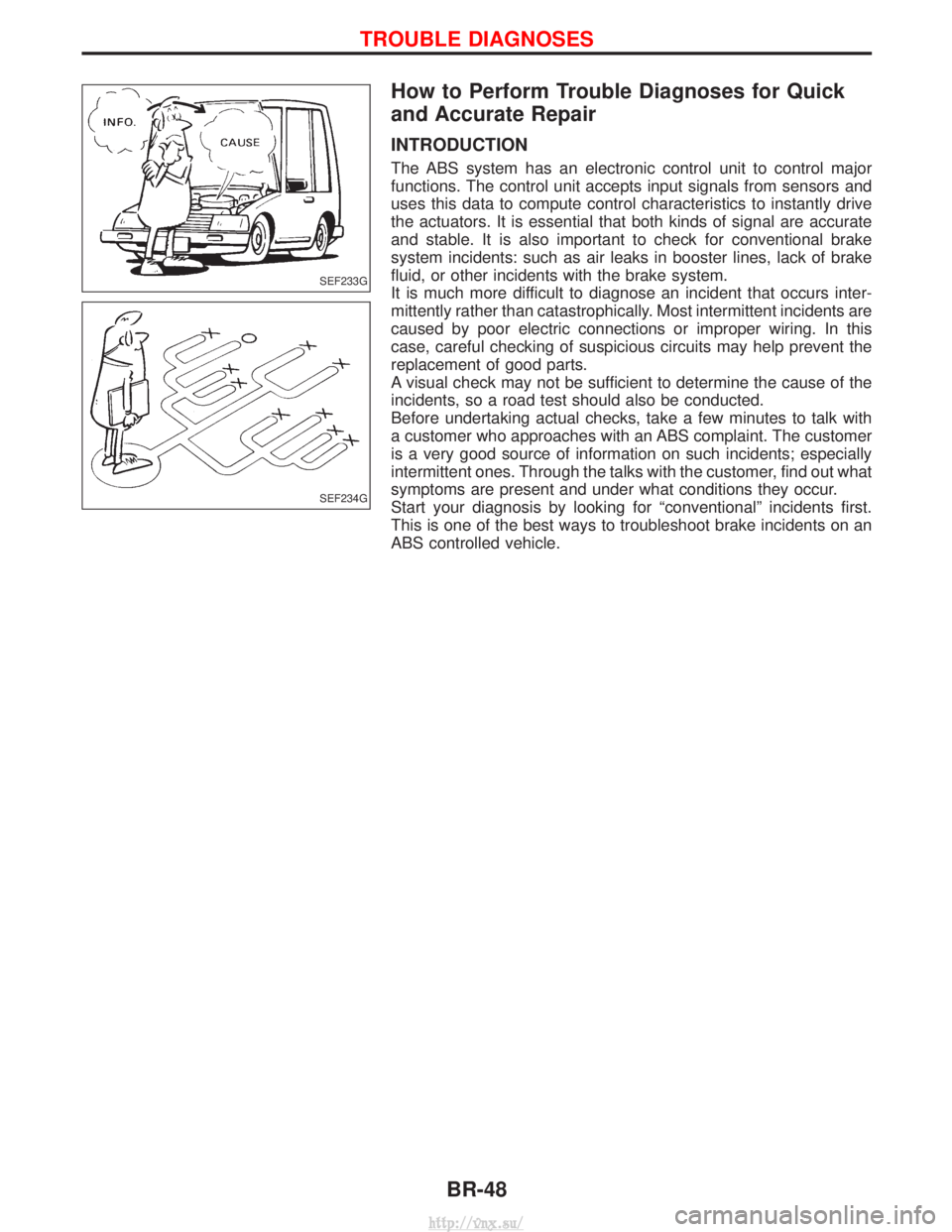
How to Perform Trouble Diagnoses for Quick
and Accurate Repair
INTRODUCTION
The ABS system has an electronic control unit to control major
functions. The control unit accepts input signals from sensors and
uses this data to compute control characteristics to instantly drive
the actuators. It is essential that both kinds of signal are accurate
and stable. It is also important to check for conventional brake
system incidents: such as air leaks in booster lines, lack of brake
fluid, or other incidents with the brake system.
It is much more difficult to diagnose an incident that occurs inter-
mittently rather than catastrophically. Most intermittent incidents are
caused by poor electric connections or improper wiring. In this
case, careful checking of suspicious circuits may help prevent the
replacement of good parts.
A visual check may not be sufficient to determine the cause of the
incidents, so a road test should also be conducted.
Before undertaking actual checks, take a few minutes to talk with
a customer who approaches with an ABS complaint. The customer
is a very good source of information on such incidents; especially
intermittent ones. Through the talks with the customer, find out what
symptoms are present and under what conditions they occur.
Start your diagnosis by looking for ªconventionalº incidents first.
This is one of the best ways to troubleshoot brake incidents on an
ABS controlled vehicle.
SEF233G
SEF234G
TROUBLE DIAGNOSES
BR-48
http://vnx.su/
Page 1248 of 1833
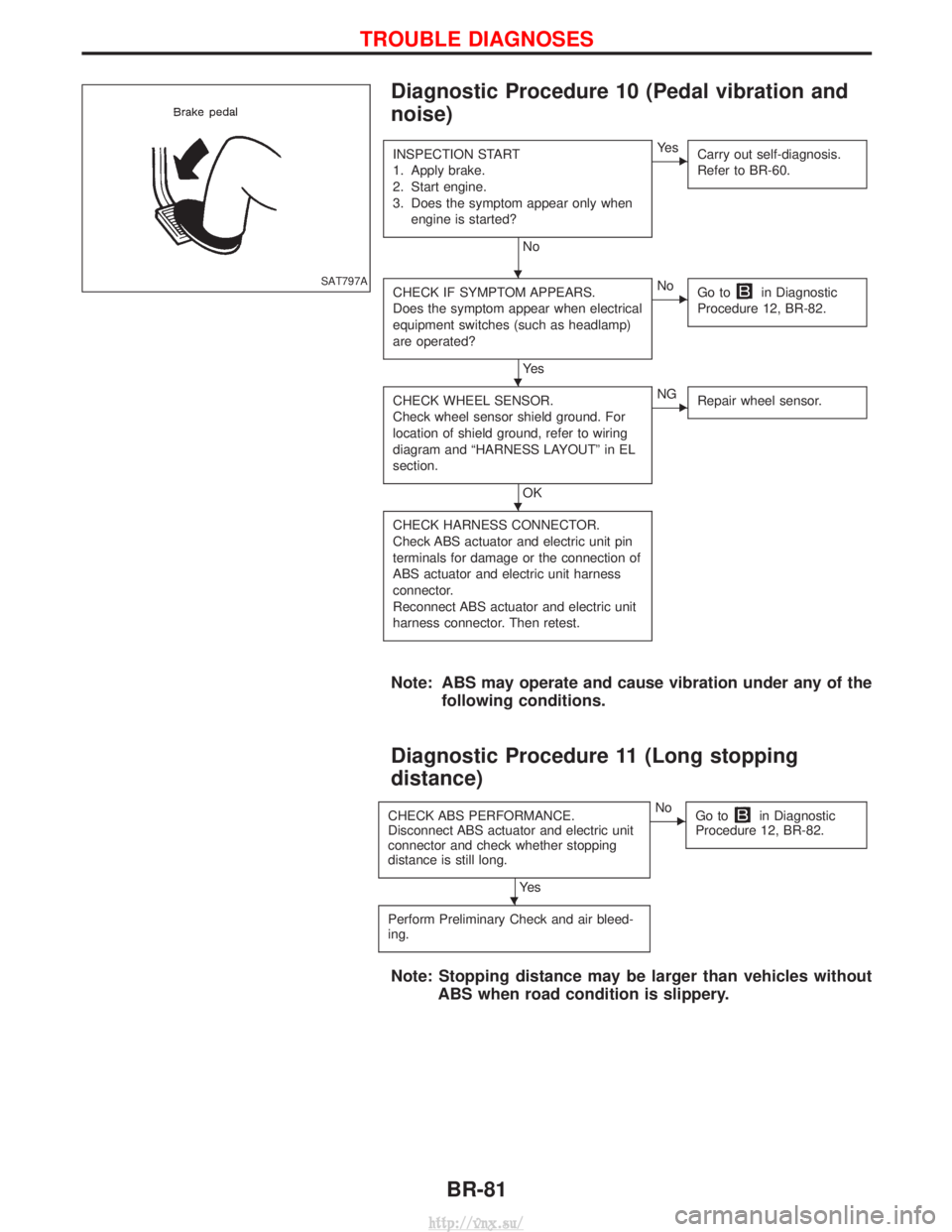
Diagnostic Procedure 10 (Pedal vibration and
noise)
INSPECTION START
1. Apply brake.
2. Start engine.
3. Does the symptom appear only whenengine is started?
No
EYe s Carry out self-diagnosis.
Refer to BR-60.
CHECK IF SYMPTOM APPEARS.
Does the symptom appear when electrical
equipment switches (such as headlamp)
are operated?
Ye s
ENoGo toin Diagnostic
Procedure 12, BR-82.
CHECK WHEEL SENSOR.
Check wheel sensor shield ground. For
location of shield ground, refer to wiring
diagram and ªHARNESS LAYOUTº in EL
section.
OK
ENG Repair wheel sensor.
CHECK HARNESS CONNECTOR.
Check ABS actuator and electric unit pin
terminals for damage or the connection of
ABS actuator and electric unit harness
connector.
Reconnect ABS actuator and electric unit
harness connector. Then retest.
Note: ABS may operate and cause vibration under any of the
following conditions.
Diagnostic Procedure 11 (Long stopping
distance)
CHECK ABS PERFORMANCE.
Disconnect ABS actuator and electric unit
connector and check whether stopping
distance is still long.
Ye s
ENoGo toin Diagnostic
Procedure 12, BR-82.
Perform Preliminary Check and air bleed-
ing.
Note: Stopping distance may be larger than vehicles without ABS when road condition is slippery.
SAT797AH
H
H
H
TROUBLE DIAGNOSES
BR-81
http://vnx.su/
Page 1287 of 1833
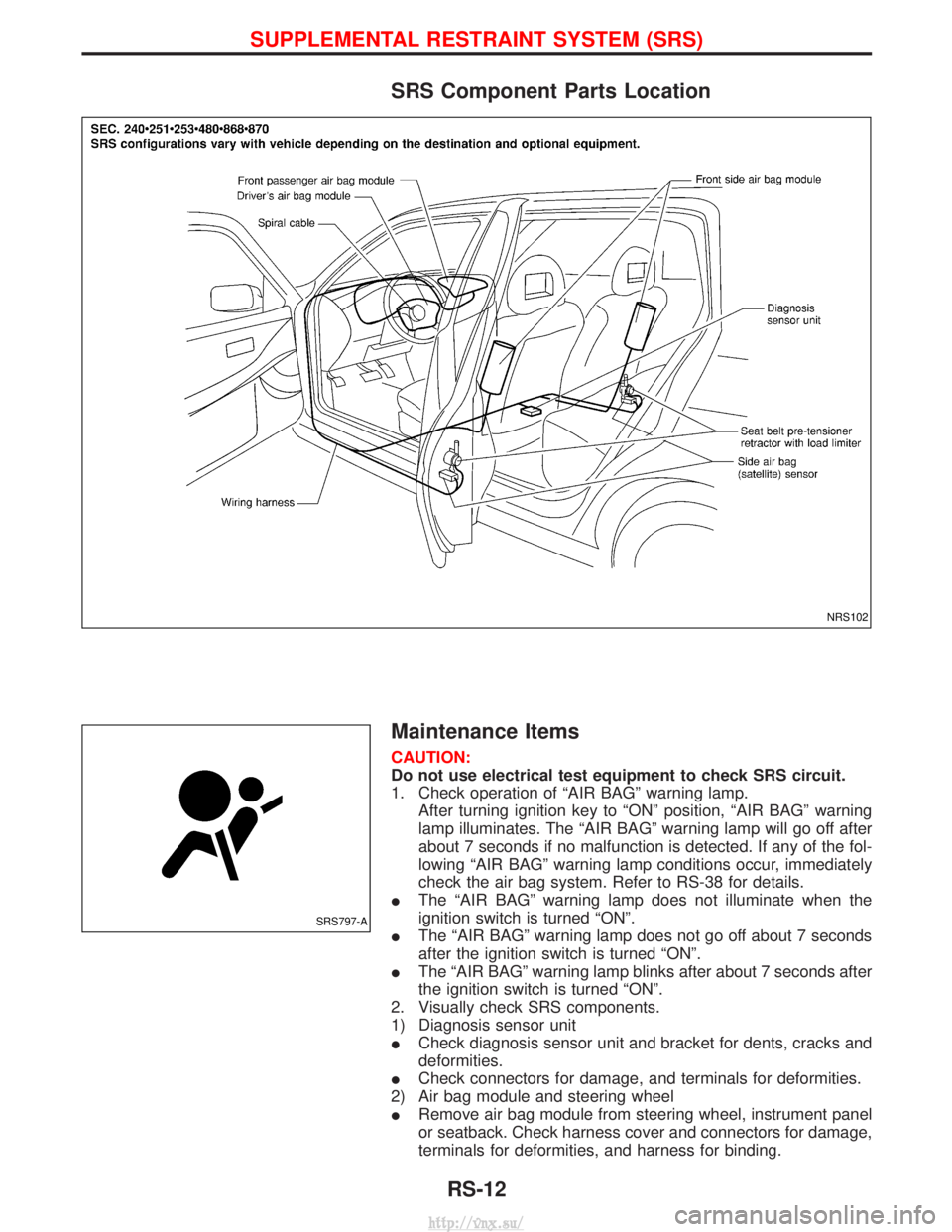
SRS Component Parts Location
Maintenance Items
CAUTION:
Do not use electrical test equipment to check SRS circuit.
1. Check operation of ªAIR BAGº warning lamp.After turning ignition key to ªONº position, ªAIR BAGº warning
lamp illuminates. The ªAIR BAGº warning lamp will go off after
about 7 seconds if no malfunction is detected. If any of the fol-
lowing ªAIR BAGº warning lamp conditions occur, immediately
check the air bag system. Refer to RS-38 for details.
I The ªAIR BAGº warning lamp does not illuminate when the
ignition switch is turned ªONº.
I The ªAIR BAGº warning lamp does not go off about 7 seconds
after the ignition switch is turned ªONº.
I The ªAIR BAGº warning lamp blinks after about 7 seconds after
the ignition switch is turned ªONº.
2. Visually check SRS components.
1) Diagnosis sensor unit
I Check diagnosis sensor unit and bracket for dents, cracks and
deformities.
I Check connectors for damage, and terminals for deformities.
2) Air bag module and steering wheel
I Remove air bag module from steering wheel, instrument panel
or seatback. Check harness cover and connectors for damage,
terminals for deformities, and harness for binding.
NRS102
SRS797-A
SUPPLEMENTAL RESTRAINT SYSTEM (SRS)
RS-12
http://vnx.su/
Page 1306 of 1833
How to Perform Trouble Diagnoses for Quick
and Accurate Repair
A good understanding of the malfunction conditions can make troubleshooting faster and more accurate.
In general, each customer feels differently about a malfunction. It is important to fully understand the symp-
toms or conditions for a customer complaint.
INFORMATION FROM CUSTOMER
WHAT ..... Vehicle model
WHEN ..... Date, Frequencies
WHERE ..... Road conditions
HOW ..... Operating conditions, Symptoms
PRELIMINARY CHECK
Check that the following parts are in good order.
IBattery [Refer to SC-3, ªBATTERYº.]
I Fuse [Refer to EL-12, ªFuseº, ªPOWER SUPPLY ROUTINGº.]
I System component-to-harness connections
SUPPLEMENTAL RESTRAINT SYSTEM (SRS)
RS-31
http://vnx.su/
Page 1313 of 1833
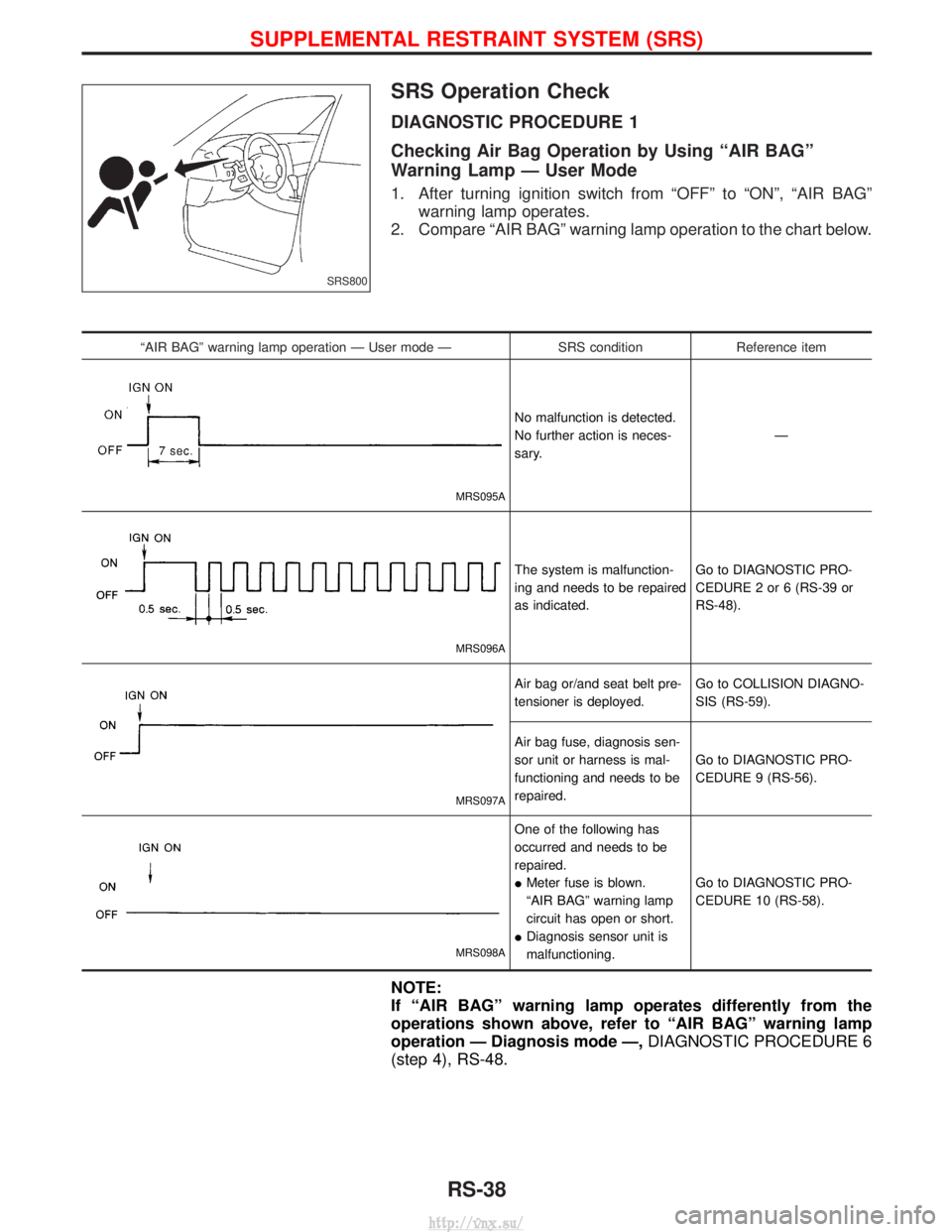
SRS Operation Check
DIAGNOSTIC PROCEDURE 1
Checking Air Bag Operation by Using ªAIR BAGº
Warning Lamp Ð User Mode
1. After turning ignition switch from ªOFFº to ªONº, ªAIR BAGºwarning lamp operates.
2. Compare ªAIR BAGº warning lamp operation to the chart below.
ªAIR BAGº warning lamp operation Ð User mode Ð SRS conditionReference item
MRS095A
No malfunction is detected.
No further action is neces-
sary. Ð
MRS096A
The system is malfunction-
ing and needs to be repaired
as indicated.Go to DIAGNOSTIC PRO-
CEDURE 2 or 6 (RS-39 or
RS-48).
MRS097A
Air bag or/and seat belt pre-
tensioner is deployed.
Go to COLLISION DIAGNO-
SIS (RS-59).
Air bag fuse, diagnosis sen-
sor unit or harness is mal-
functioning and needs to be
repaired. Go to DIAGNOSTIC PRO-
CEDURE 9 (RS-56).
MRS098A
One of the following has
occurred and needs to be
repaired.
I
Meter fuse is blown.
ªAIR BAGº warning lamp
circuit has open or short.
I Diagnosis sensor unit is
malfunctioning. Go to DIAGNOSTIC PRO-
CEDURE 10 (RS-58).
NOTE:
If ªAIR BAGº warning lamp operates differently from the
operations shown above, refer to ªAIR BAGº warning lamp
operation Ð Diagnosis mode Ð,
DIAGNOSTIC PROCEDURE 6
(step 4), RS-48.
SRS800
SUPPLEMENTAL RESTRAINT SYSTEM (SRS)
RS-38
http://vnx.su/
Page 1324 of 1833
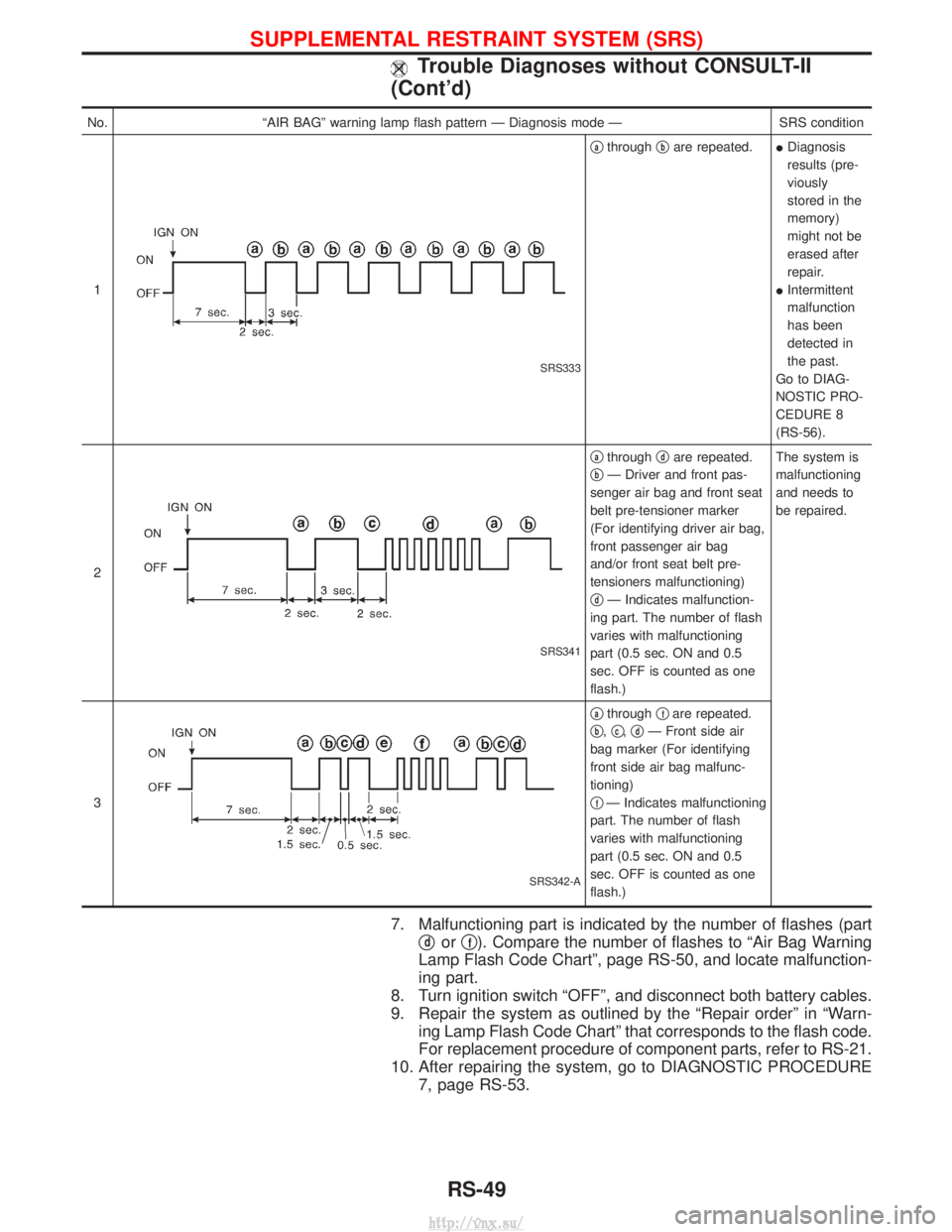
No.ªAIR BAGº warning lamp flash pattern Ð Diagnosis mode Ð SRS condition
1
SRS333
qathrough qbare repeated.
IDiagnosis
results (pre-
viously
stored in the
memory)
might not be
erased after
repair.
I Intermittent
malfunction
has been
detected in
the past.
Go to DIAG-
NOSTIC PRO-
CEDURE 8
(RS-56).
2
SRS341
qathrough qdare repeated.
q
bÐ Driver and front pas-
senger air bag and front seat
belt pre-tensioner marker
(For identifying driver air bag,
front passenger air bag
and/or front seat belt pre-
tensioners malfunctioning)
q
dÐ Indicates malfunction-
ing part. The number of flash
varies with malfunctioning
part (0.5 sec. ON and 0.5
sec. OFF is counted as one
flash.) The system is
malfunctioning
and needs to
be repaired.
3
SRS342-A
qathrough qfare repeated.
q
b, qc,qdÐ Front side air
bag marker (For identifying
front side air bag malfunc-
tioning)
q
fÐ Indicates malfunctioning
part. The number of flash
varies with malfunctioning
part (0.5 sec. ON and 0.5
sec. OFF is counted as one
flash.)
7. Malfunctioning part is indicated by the number of flashes (part q
dorqf). Compare the number of flashes to ªAir Bag Warning
Lamp Flash Code Chartº, page RS-50, and locate malfunction-
ing part.
8. Turn ignition switch ªOFFº, and disconnect both battery cables.
9. Repair the system as outlined by the ªRepair orderº in ªWarn- ing Lamp Flash Code Chartº that corresponds to the flash code.
For replacement procedure of component parts, refer to RS-21.
10. After repairing the system, go to DIAGNOSTIC PROCEDURE 7, page RS-53.
SUPPLEMENTAL RESTRAINT SYSTEM (SRS)
Trouble Diagnoses without CONSULT-II
(Cont'd)
RS-49
http://vnx.su/
Page 1330 of 1833
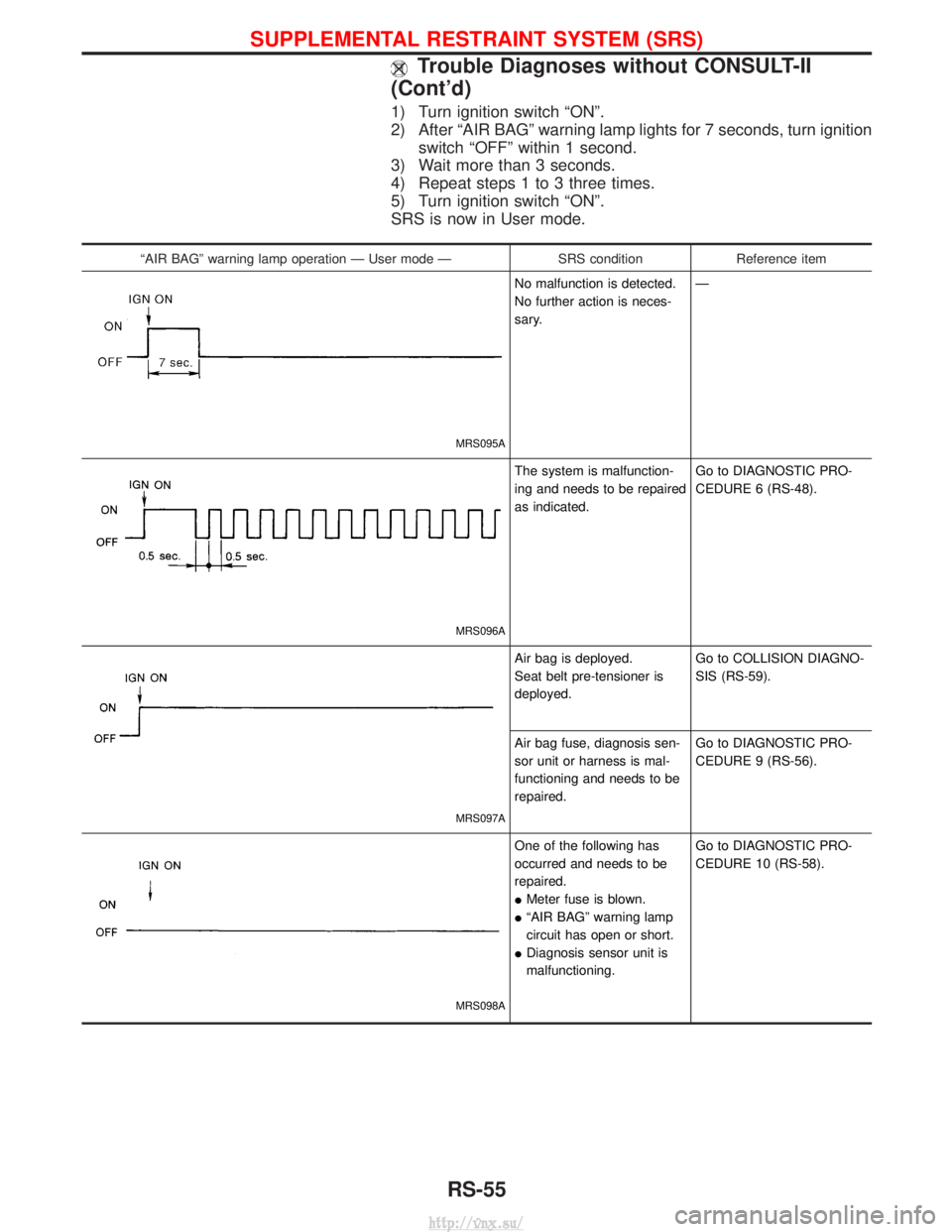
1) Turn ignition switch ªONº.
2) After ªAIR BAGº warning lamp lights for 7 seconds, turn ignitionswitch ªOFFº within 1 second.
3) Wait more than 3 seconds.
4) Repeat steps 1 to 3 three times.
5) Turn ignition switch ªONº.
SRS is now in User mode.
ªAIR BAGº warning lamp operation Ð User mode Ð SRS conditionReference item
MRS095A
No malfunction is detected.
No further action is neces-
sary. Ð
MRS096A
The system is malfunction-
ing and needs to be repaired
as indicated.Go to DIAGNOSTIC PRO-
CEDURE 6 (RS-48).
MRS097A
Air bag is deployed.
Seat belt pre-tensioner is
deployed.Go to COLLISION DIAGNO-
SIS (RS-59).
Air bag fuse, diagnosis sen-
sor unit or harness is mal-
functioning and needs to be
repaired. Go to DIAGNOSTIC PRO-
CEDURE 9 (RS-56).
MRS098A
One of the following has
occurred and needs to be
repaired.
I
Meter fuse is blown.
I ªAIR BAGº warning lamp
circuit has open or short.
I Diagnosis sensor unit is
malfunctioning. Go to DIAGNOSTIC PRO-
CEDURE 10 (RS-58).
SUPPLEMENTAL RESTRAINT SYSTEM (SRS)
Trouble Diagnoses without CONSULT-II
(Cont'd)
RS-55
http://vnx.su/
Page 1342 of 1833
Checking Body Corrosion
Visually check the body sheet metal panel for corrosion, paint damage (scratches, chipping, rubbing, etc.) or
damage to the anti-corrosion materials. In particular, check the following locations.
Hemmed portion
Hood front end, door lower end, back door rear end, etc.
Panel joint
Side sill of rear fender and center pillar, rear wheel housing of rear fender, around strut tower in engine
compartment, etc.
Panel edge
Back door opening, sunroof opening, fender wheelarch flange, fuel filler lid flange, around holes in panel, etc.
Parts contact
Waist molding, windshield molding, bumper, etc.
Protectors
Damage or condition of mudguard, fender protector, chipping protector, etc.
Anti-corrosion materials
Damage or separation of anti-corrosion materials under the body.
Drain holes
Condition of drain holes at door and side sill.
When repairing corroded areas, refer to the Corrosion Repair Manual.
CHASSIS AND BODY MAINTENANCE
BT-5
http://vnx.su/